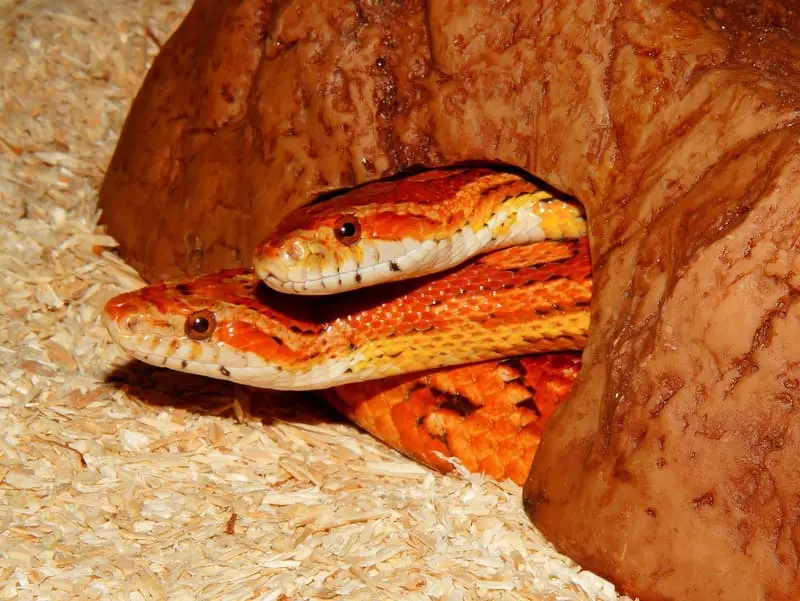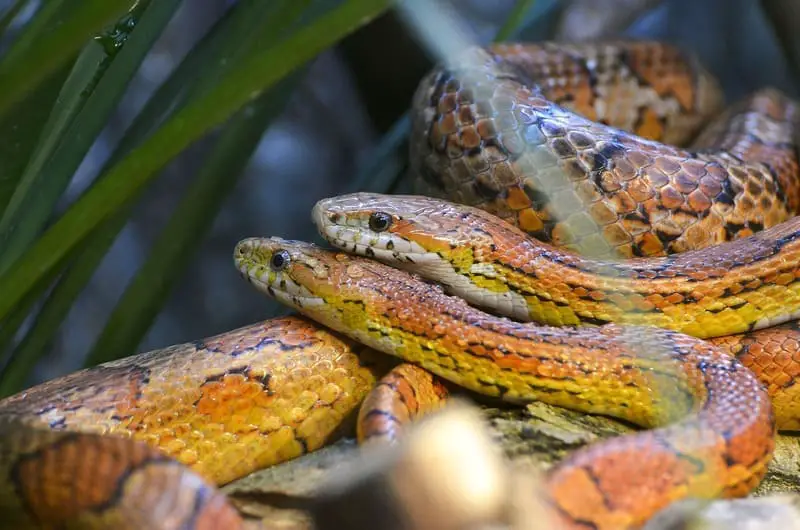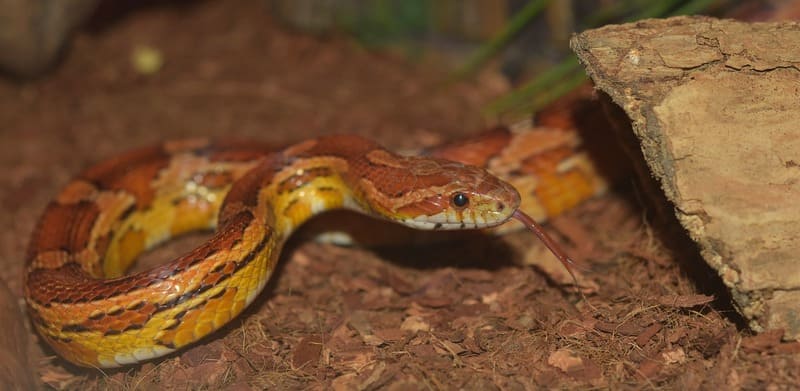Corn snakes (Pantherophis guttatus) are popular pet reptiles known for their docile nature, manageable size, and striking appearance. These snakes are native to North America and are a favorite among hobbyists and enthusiasts. One common question that arises when keeping corn snakes as pets is whether they can live together in the same enclosure. In this comprehensive guide, we’ll explore the complexities of keeping corn snakes together, including the benefits, risks, and important considerations for a successful cohabitation.

Understanding Corn Snakes
Before delving into the intricacies of whether corn snakes can live together, it’s essential to understand the species and their natural behaviors.
Natural Habitat
Corn snakes are primarily found in the southeastern United States. They inhabit a wide range of environments, including forests, grasslands, and abandoned buildings. This adaptable nature allows them to thrive in a variety of conditions.
Physical Characteristics
Corn snakes typically grow to a length of 3 to 5 feet, with males being slightly smaller than females. They have slender bodies and are known for their vibrant and varied color patterns, which can include red, orange, brown, and black. These snakes have a reputation for being non-venomous, making them suitable for many novice reptile keepers.
Behavior
Corn snakes are generally docile and tend to be more active during the twilight hours or at night. They are skilled climbers and are adept at escaping from enclosures if not properly secured. When threatened, they may adopt defensive behaviors like hissing or vibrating their tails, mimicking a rattlesnake. However, their primary defense mechanism is to hide or flee.
The Pros of Cohabiting Corn Snakes
Keeping corn snakes together in the same enclosure has several potential advantages. Here are some of the key benefits:
1. Social Interaction
Cohabiting corn snakes may engage in natural social behaviors, such as basking together and exploring their environment. This interaction can be fascinating to observe and can provide enrichment for the snakes.
2. Space Efficiency
Cohabiting corn snakes can reduce the space and resources needed for multiple enclosures. This can be especially beneficial for hobbyists with limited room or resources.
3. Observation and Education
Cohabiting corn snakes can be an educational opportunity for snake enthusiasts. Observing their interactions, behaviors, and breeding can provide a valuable learning experience.
4. Reduced Loneliness
Some argue that cohabitation may help alleviate potential loneliness in pet snakes. While reptiles are not typically considered social animals, the presence of a conspecific (a member of the same species) may provide a degree of companionship.

The Cons of Cohabiting Corn Snakes
While there are potential benefits to cohabiting corn snakes, there are also significant drawbacks and risks to consider.
1. Aggression and Competition
Cohabiting corn snakes can display aggression towards each other. This aggression may be due to competition for resources, territory, or breeding opportunities. In some cases, it can lead to injuries or even death.
2. Stress and Anxiety
Corn snakes kept together may experience stress and anxiety, particularly if they are not compatible or if there is not enough space for them to establish separate territories. This can lead to health problems and a lower quality of life for the snakes.
3. Disease Transmission
Cohabiting snakes are more likely to transmit diseases or parasites to each other, as they are in closer proximity. This is a significant concern for their health and can lead to costly veterinary bills and potential loss of snakes.
4. Difficulty in Monitoring
It can be challenging to monitor the health and well-being of cohabiting snakes. Any issues, such as illness or injury, may go unnoticed until they become severe.
5. Breeding Challenges
If the goal is to breed corn snakes, cohabiting them may not be the best approach. Mating and egg-laying can be disrupted by the presence of other snakes, leading to unsuccessful breeding attempts.
When Can Corn Snakes Live Together?
While the idea of keeping corn snakes together is generally discouraged due to the risks involved, there are some specific scenarios in which cohabitation might work under controlled conditions.
1. Sibling Snakes
Cohabiting corn snakes from the same clutch (siblings) can be a more viable option. These snakes are already familiar with each other and may have a better chance of peacefully coexisting, provided they have ample space, hiding spots, and access to resources.
2. Large Enclosures
If you plan to cohabit corn snakes, it’s essential to provide a spacious enclosure. A larger enclosure allows the snakes to establish separate territories and reduces the likelihood of territorial disputes and aggression. The enclosure should include multiple hiding spots and climbing opportunities to accommodate the snakes’ needs.
3. Expert Supervision
Cohabiting corn snakes should only be attempted by experienced reptile keepers who can closely monitor the snakes’ behavior and well-being. An expert can intervene if any issues arise and can recognize signs of stress, aggression, or illness.
4. Compatibility
Compatibility is crucial when considering cohabitation. Not all corn snakes will get along, even if they are siblings or housed in a large enclosure. It’s essential to be prepared to separate the snakes if aggression or stress is observed.
5. Same Gender
Keeping snakes of the same gender together is generally less risky than cohabiting males and females. The presence of both males and females can lead to breeding attempts, which can be problematic and stressful for the snakes.
6. Observation Period
Before permanently cohabiting corn snakes, it’s advisable to observe them in a neutral environment for a period to assess their compatibility. This can help determine whether they are likely to coexist peacefully.

Tips for Cohabiting Corn Snakes
If you decide to proceed with cohabiting corn snakes, there are several important tips to follow to increase the chances of a successful arrangement.
1. Provide Adequate Space
As mentioned earlier, a spacious enclosure is crucial for cohabiting corn snakes. The enclosure should be large enough to allow each snake to establish its territory and avoid confrontations.
2. Multiple Hiding Spots
Include multiple hiding spots in the enclosure, such as caves, branches, and plant decorations. These hiding spots allow snakes to retreat when they need privacy or feel threatened.
3. Ensure Proper Temperature and Humidity
Maintain the appropriate temperature and humidity levels for corn snakes. Consistently monitor and regulate these conditions to ensure the snakes’ well-being.
4. Regular Health Checks
Perform regular health checks on the cohabiting snakes. Keep an eye out for signs of stress, injuries, or illness. If you notice any issues, be prepared to separate the snakes.
5. Feeding Considerations
Feeding cohabiting snakes can be challenging. Ensure that each snake receives the appropriate amount of food and that there is no competition or aggression during feeding time.
6. Separation Plan
Have a plan in place for separating the snakes if cohabitation becomes problematic. This plan may involve providing separate enclosures and addressing any health or behavioral issues.
7. Expert Guidance
Consult with experienced reptile keepers, breeders, or herpetologists for guidance on cohabiting corn snakes. Their expertise can help you navigate the complexities of snake cohabitation successfully.
Common Myths and Misconceptions
There are several myths and misconceptions surrounding cohabiting corn snakes. It’s essential to debunk these falsehoods to make informed decisions about keeping these reptiles together.
1. Corn Snakes Are Social Animals
One common misconception is that corn snakes are social animals and benefit from living together. In reality, corn snakes are not social creatures and do not have the same social structure or behaviors as pack animals, such as dogs or some other mammals.
2. Siblings Always Get Along
While sibling snakes may have a better chance of cohabiting peacefully, it’s not guaranteed. Sibling rivalry and competition for resources can still occur. It’s essential to monitor their interactions and be prepared to separate them if necessary.
3. Breeding Is Easier in Groups
Cohabiting male and female corn snakes does not necessarily make breeding easier. In fact, it can lead to stress, aggression, and disrupted breeding attempts. Successful breeding typically occurs when the male and female are introduced for mating but are otherwise kept separately.
4. Cohabiting Saves Space
While cohabiting corn snakes can save space, it’s crucial to balance this with the potential risks. Inadequate space can lead to aggression and stress, negating any space-saving benefits.
5. Separation Is Not Necessary
Some believe that once corn snakes are cohabiting, they should always stay together. This is not the case. If any issues arise, such as aggression or stress, it’s essential to have a plan for separating the snakes to ensure their well-being.
Conclusion
The question of whether corn snakes can live together is complex, with both advantages and disadvantages to consider. While cohabiting corn snakes may be possible in some situations, it requires careful planning, a deep understanding of the species, and a commitment to monitoring the snakes’ well-being. In general, it is recommended to err on the side of caution and house corn snakes separately to ensure their safety and quality of life.
If you are determined to cohabit corn snakes, remember that it should be undertaken with great care, only by experienced keepers, and with a focus on creating a habitat that minimizes stress and competition. The welfare of the snakes should always be the top priority, and you should be prepared to separate them if any issues arise.
Ultimately, whether or not to cohabitate corn snakes is a decision that should be made thoughtfully and based on the specific needs and behaviors of the individual snakes. Always seek advice from experts and veterinarians to ensure the well-being of your pet corn snakes.
